



Robinson Transportation Consulting
Royal Oak Roundabout Safety Improvements
Road Safety Review
Scheme/Preliminary Design
May 2018
 R
obinson Transportation Consulting
R
obinson Transportation Consulting
This document has been prepared for the benefit of Auckland Transport. No liability is accepted by this
company or any employee or sub-consultant of this company with respect to its use by any other person.
This disclaimer shall apply notwithstanding that the report may be made available to other persons for
an application for permission or approval to fulfil a legal requirement.
Robinson Transportation Consulting
s7(2)(a) Privacy , Pr.Eng. (RSA), M.Eng., B.Sc.Eng. (Civil)
PO Box 5015
Mount Maunganui 3150
Phone s7(2)(a)
Privacy
E-mail: s7(2)(a) Privacy
© Robinson Transportation Consulting
This document is and shall remain the property of Robinson Transportation Consulting. The
document may only be used for the purposes for which it was commissioned and in accordance with
the Terms of Engagement for the commission. Unauthorised use of this document in any form
whatsoever is prohibited.
Document Status
Rev
Reviewer
Approved for Issue
Author
No.
Name
Signature
Name
Signature
Date
A
s7(2)
s7(2)
18/05/18
(a)
(a)
Privac
Privac
y
y
B
C
D
Revision A
20/06/2
- 0
1
2 8-
RoyalOakSafetyReview_v1
Robinson Transportation Consulting
Contents
1.
Introductory Statement ................................................................................................................. 1
1.1
Introduction .................................................................................................................... 1
1.2
Reviewer ......................................................................................................................... 2
1.3
Methodology .................................................................................................................. 2
1.4
Project documentation, briefing meeting and site visit .................................................. 2
1.5
Ranking system .............................................................................................................. 3
1.6
Disclaimer ...................................................................................................................... 4
2
Safety Review Findings and Recommendations .......................................................................... 5
2.1
Speed management and consistency (C.U=Moderate) .................................................. 5
2.2
Intersection and network form (Comment) .................................................................... 7
2.3
Approach lane pre-segregation and entry curve design (C.U=Moderate) ..................... 8
2.4
Deflection and path overlap through the roundabout (O.U=Moderate) ....................... 10
2.5
Central island conspicuity (O.U=Moderate) ................................................................ 12
2.6
Circulatory roadway markings (C.VU=Moderate) ...................................................... 13
2.7
Pedestrian crossing points at roundabout splitter islands (C.L=Significant) ............... 14
2.8
Bicycle path continuity and wayfinding (O.VL=Significant) ...................................... 15
3
Review Statement ....................................................................................................................... 17
Appendix A: Roundabout Improvements Concept Design ................................................................... 1
Appendix B: Tracking Curves (Rubbish Trucks) .................................................................................. 2
Appendix C: Crash Record (2012-2016) .............................................................................................. 3
Appendix D: Traffic Surveys ................................................................................................................. 4
Appendix E: Review Markup* of Roundabout Improvements Concept Design ................................... 7
- 1 -
Revision A
20/06/2018
RoyalOakSafetyReview_v1
link to page 21 link to page 21
 Robinson Transportation Consulting
Robinson Transportation Consulting
1. Introductory Statement
1.1 Introduction
This report presents the findings of a scheme/preliminary design stage safety review of the
proposed safety improvements to the Royal Oak roundabout intersection in Auckland.
The project extent is indicated on Figure 1. The proposed preliminary design has been
prepared by GHD, Auckland on behalf of the Auckland Transport (see
Appendix A:
Roundabout Improvements Concept Design). The primary proposed improvements to the
existing roundabout is to add raised pedestrian crossings across all legs of the roundabout,
reshaping of the central island, extensions to the splitters islands, additional spiral markings
within the circulatory roadway and advanced directional signs.
Figure 1 Approximate extent of project
- 1 -
Revision A
20/06/2018
RoyalOakSafetyReview_v1
Robinson Transportation Consulting
1.2 Reviewer
This safety review is the first for the proposed intersection improvements. It was suggested
by NZTA prior to safety funding assistance with any design changes. Given that it is a
review of one concept design drawing, together with crash records and traffic surveys, the
safety review team comprised of a single experienced1 roundabout safety auditor:
s7(2)(a) Privacy
Pr.Eng. (RSA), M.Eng., B.Sc.Eng. (Civil)
Robinson Transportation Consulting, Tauranga
It is understood that a more formal safety audit will be required in due course.
1.3 Methodology
The review generally follows the guidelines contained within the NZ Transport Agency
document “Road Safety Audit Procedures for Projects, Guidelines, Interim Release, May
2013” and is complemented by the reviewer’s experience with other complex multi-lane
roundabouts.
This review should not be regarded as a complete “quality check” of the project. It focuses
essentially on safety issues that are considered significant regarding the proposed design.
The review has identified road safety concerns and made recommendations about corrective
actions. Whilst these recommendations may indicate the nature or direction of a solution,
they do not necessarily provide specific details of how to address or resolve that concern.
Responsibility for the solution of any safety issue identified remains with the designer.
1.4 Project documentation, briefing meeting and site visit
The reviewer was provided with the following materials:
1. A preliminary design plan. A copy of this drawing is contained in Appendix A.
2. Swept paths tracking rubbish trucks and buses. An example drawing is provided in
Appendix B.
3. “Royal Oak Roundabout – Analysis and Summary” background document.
4. Traffic surveys of peak hour multi-modal origin-destinations, approach queue
lengths, pedestrian crossings.
5. Sidra operational capacity analyses.
The reviewer carried out a desk-top audit of these documents.
A site tour during the AM peak period and briefing meetings were held with the GHD traffic
engineers (Jason Chow and Inho Lim) and the Auckland Transport project manager
(Winston Gee), on 13th April 2018 followed by a detailed site inspection on the same
afternoon. The weather was fine for the site visit.
1
Principal Investigator, “Roundabouts: An Informational Guide” (First Edition), U.S. Federal
Highway Administration, 2002.
- 2 -
Revision A
20/06/2018
RoyalOakSafetyReview_v1
Robinson Transportation Consulting
1.5 Ranking system
The potential road safety problems identified have been ranked as follows:
The probable crash frequency is qualitatively assessed based on expected exposure (how
many road users will be exposed to a safety issue) and the probability of a crash resulting
from the presence of the issue. The likely severity of a crash outcome is qualitatively
assessed based on factors such as expected speeds, type of collision, and type of users
involved.
Reference to historic crash rates or other research for similar elements of projects, or
projects as a whole; have been drawn on where appropriate to assist in understanding the
likely crash types, frequency and likely severity that may result from a particular concern.
The frequency and severity ratings are used together to develop a combined qualitative
ranking for each safety issue using the Concern Assessment Rating Matrix in
Table 1 below. The qualitative assessment requires professional judgement and a wide range of
experience in projects of all sizes and locations.
Table 1: Assessment Matrix
Likelihood of
Probability of a Crash Occurring
Fatality or
Serious Injury
Frequent
Common
Occasional
Infrequent
Very Likely
Serious
Serious
Significant
Moderate
Likely
Serious
Significant
Moderate
Moderate
Unlikely
Significant
Moderate
Minor
Minor
Very Unlikely
Moderate
Minor
Minor
Minor
While all safety concerns should be considered for action, the client or nominated project
manager will make the decision as to what course of action will be adopted based on the
guidance given in this ranking process with consideration to factors other than safety alone.
As a guide, a suggested action for each concern category is given in
Table 2 below.
Table 2: Categories of Concern
CONCERN
Suggested Action
Serious concern that must be addressed and requires changes to
Serious
avoid serious safety consequences.
Significant concern that should be addressed and requires
Significant
changes to avoid serious safety consequences.
Moderate
Moderate concern that should be addressed to improve safety
Minor concern that should be addressed where practical to
Minor
improve safety.
- 3 -
Revision A
20/06/2018
RoyalOakSafetyReview_v1
Robinson Transportation Consulting
In addition to the ranked safety issues it is appropriate for the safety reviewer to provide
additional comments with respect to items that may have a safety implication but lie outside
the scope of the safety review. A comment may include items where the safety implications
are not yet clear due to insufficient detail for the stage of the project, items outside the scope
of the review such as existing issues not impacted by the project or an opportunity for
improved safety but not necessarily linked to the project itself. While typically comments
do not require a specific recommendation, in some instances the reviewer may give
suggestions.
1.6 Disclaimer
The findings and recommendations in this report are based on an examination of available
relevant plans, the specified road and its environs, and the opinions of the reviewer.
However, it must be recognised that eliminating safety concerns cannot be guaranteed since
no road can be regarded as absolutely safe and no warranty is implied that all safety issues
have been identified in this report. Safety reviews do not constitute a design review or an
assessment of standards with respect to engineering or planning documents. Readers are
urged to seek specific technical advice on matters raised and not rely solely on the report.
While every effort has been made to ensure the accuracy of the report, it is made available
on the basis that anyone relying on it does so at their own risk without any liability to the
safety reviewer or their organisation.
- 4 -
Revision A
20/06/2018
RoyalOakSafetyReview_v1
Robinson Transportation Consulting
2 Safety Review Findings and Recommendations
The following safety review findings may pertain to either the existing condition or the
proposed design modifications. The category of concern has been indicated in each sub-
heading, based on the exposure probability x severity likelihood. It is left to the parties
involved to respond appropriately, according to their separate or shared responsibilities for
each of the safety concerns that have been identified. In some cases, the timing of safety
improvements may be triggered by re-development of land on the various frontages of the
roundabout intersection.
2.1 Speed management and consistency (C.U=Moderate)
The site currently has a 50 km/h speed limit on the urban approach roads. However,
roundabout entry speeds should ideally be less than 40 km/h, with sought-after speed
consistency criteria (relative speeds) of no more than 20km/h and less than 10km/h desirable
between consecutive geometric elements or conflicting traffic streams. When bicyclists are
required to share lanes with general traffic, as is the case at this site, then an even slower
circulatory roadway speed is considered appropriate to maintain relative speed consistency,
thus making “claiming” or the lane and circulating safer.
The required speed reduction on entry and circulatory roadway negotiation is usually
achieved through horizontal deflection in greenfield sites. As has been noted in this retrofit
environment, however, there is little scope for provision of additional horizontal deflection
given the constrained land-uses and rights of way. In fact the “urban village” environment
that has developed around this intersection, with intense multi-modal activity has led to a
need to consider sharing space between these conflicting local and through trip desire lines.
In this regard, it is notable that only 5 of the 17 injury or fatal crashes were vehicle-vehicle
crashes with the majority of crashes involving more vulnerable users: either pedestrians,
bicyclist, motorcycles or mopeds. In such a situation transitioning to a lower 30km/h speed
limit zone with 300-500m of the roundabout and prior to the shops and crosswalks may
more appropriate to consider.
Although vertical deflections such as entry and/or exit speed humps or tables can be a safety
concern in high speed environments, they are generally considered acceptable in speed-
constrained and lower traffic flow situations such as on roundabout legs to local or collector
roads, such as Campell Road in this case. However, they are not usually found on arterial
roads, such as Mount Albert Road, Mount Smart Road or Manukau Road due to the
inconvenience to higher traffic flows and heavy vehicles including buses and emergency
vehicles. Consideration could be given to a more sinusoidal speed hump profile2,3 on the
leading edges, that would be more comfortable to traverse for bicyclists and bus passengers.
It is understood that this safety-focused project may be followed by an urban design
investigation that could more fully explore some shared-space concepts, including a raised
intersection or street blocks.
2
‘Traffic Calming - Sinusoidal, `H’ and `S’ Humps | TRL’. (https://trl.co.uk/reports/TRL377)
Accessed 15 May 2018. .
3
https://at.govt.nz/media/807636/ATCOP-Drawing-set-Chapter-8-Traffic-Calming.pdf
- 5 -
Revision A
20/06/2018
RoyalOakSafetyReview_v1
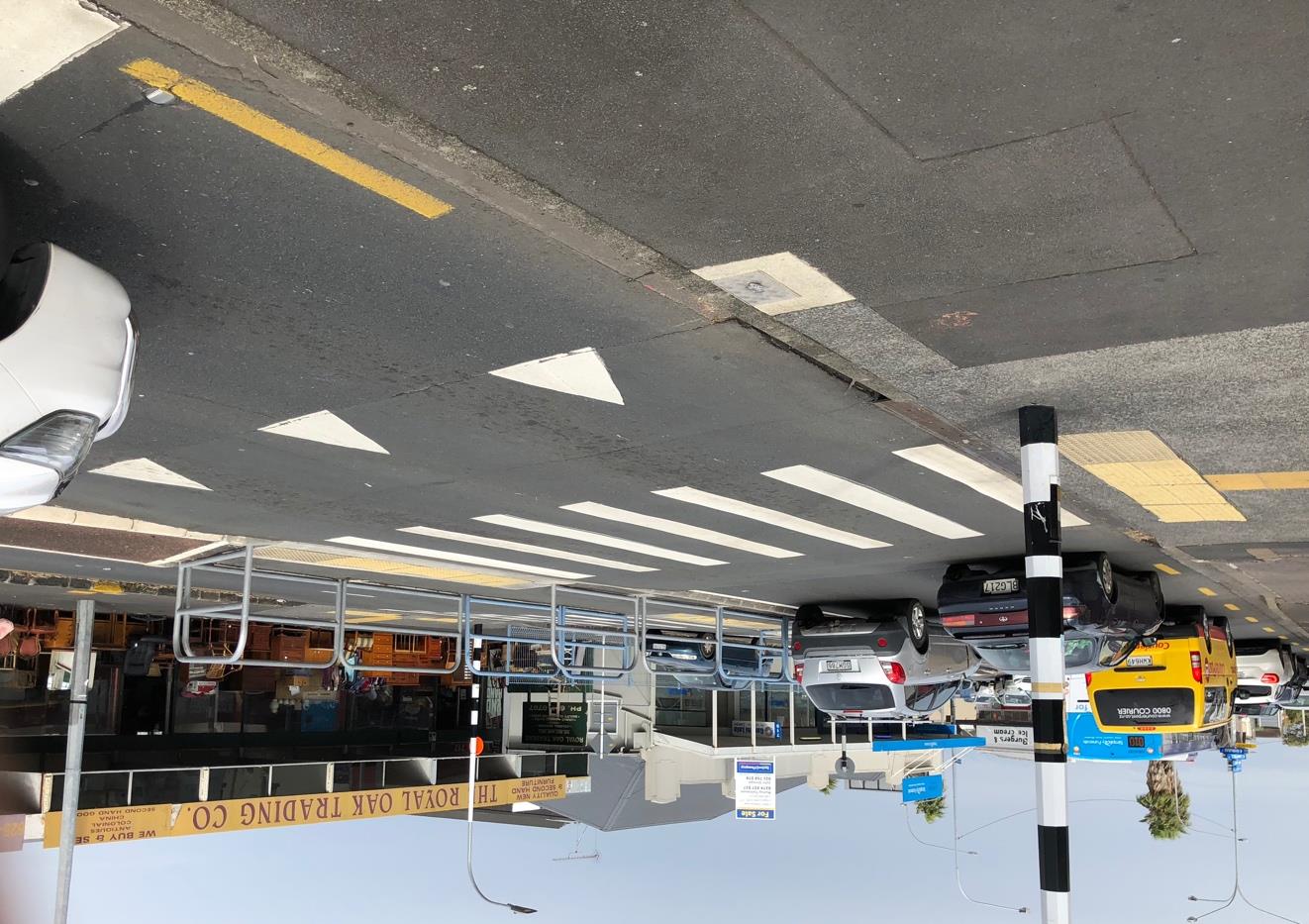 Robinson Transportation Consulting
Robinson Transportation Consulting
At this site a fatal crash involving a pedestrian crossing has resulted in a raised crosswalk
being installed on Mount Smart Road, with a supplementary in-pavement active road stud
system which are activated by pedestrians present at the crossing. The active road studs
have also been implemented on the Campbell Road leg, albeit without a raised crosswalk.
During the site visit, it was noted that these road studs tended to de-activate quite a while
after pedestrians had passed through the crosswalk. Many of them are also becoming
pressed into the asphalt concrete surround, possibly making them less visible. It is important
that their operation is tuned and maintained so that, over time, drivers do not become de-
sensitised and disregard such warning lights as seemingly unresponsive to actual conditions
at the crosswalks. As a result of these retro-fitted treatments, there are now a variety of
inconsistent pedestrian and driver user experiences across the various legs of this
roundabout. The proposed design aims to provide greater consistency at these crosswalks.
Figure 2 Vertical deflection at raised pedestrian crossing of Mount Albert Road
Recommendations
a) Consider the appropriateness of the 50km/h posted speed limit on all roundabout
legs though the Royal Oaks commercial area and whether it should be reduced to
encourage safer crossings and consecutive roundabout entry and negotiation
speeds that are safe and consistent with the road environment.
b) Design raised crosswalks to be adequately signed and marked, longitudinal profiles
of the vertical deflection zones that are comfortably traversable by buses and
emergency vehicles, appropriate to the flow function of an arterial street.
c) Ensure that active road studs are correctly timed and maintained to maximise their
effectiveness. For consistency consider installing them on all crosswalks to the
roundabout.
- 6 -
Revision A
20/06/2018
RoyalOakSafetyReview_v1
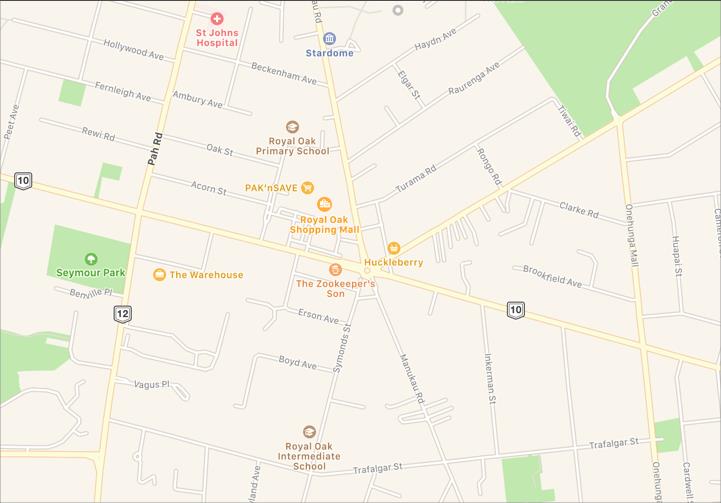 Robinson Transportation Consulting
Robinson Transportation Consulting
2.2 Intersection and network form (Comment)
In the current configuration (Figure 1), the circulatory roadway is variable with 3 lanes in
front of three of the splitter islands, and 1 lane in front of the other two splitter islands. The
safety record of roundabouts with multiple entries or exits and three circulatory lanes is
mixed with increased risk of entry- or exit-path overlap and side-swipe crashes and depends
on careful coordination of the various roundabout design elements that control entry speeds
and path overlap within the circulatory roadway. The proposed design includes a
modification of the circulatory roadway lane configuration, reducing it to 2 lanes in front
of two splitter islands and a single lane in front of the other three splitter islands (Appendix
A). This should reduce the number of lane change conflicts that are possible within the
roundabout as well as slowing the circulating speeds (possibly trading off some capacity).
At a conceptual design stage, it is also appropriate to consider alternative forms of access
or control and their relative safety performance. For example, other treatments could
include reconfiguration to a signalised intersection, alternative roundabout configurations
or alternative routes and way-finding measures to bypass this site and divert some traffic
demand.
Figure 3 Vicinity map showing wider network route options
In the project briefing meeting it was mentioned that other central island shapes have been
considered, as well as removing an exit lane on Mount Albert Road, a turbo-roundabout
treatment with kerb-separated circulatory lanes, and staggering the pedestrian crossings.
The possibility of a subsequent urban design study that included consideration of a raised
shared space on Campbell Road leg with a driveway apron treatment at the roundabout was
also discussed, as well as possible bypass alleys or streets.
- 7 -
Revision A
20/06/2018
RoyalOakSafetyReview_v1
Robinson Transportation Consulting
Therefore, without further information the reviewer is reluctant to opine on whether the
form and location of the roundabout is the best solution in terms of a safe system design for
this specific location. However, in general terms, it should be noted that a well-designed
multi-lane roundabout can provide an appropriate safe system design for an intersection.
Recommendation
At an appropriate time, consider a project scoped to focus on urban design and the
relative merits of alternative roundabout configurations and/or alternative network
options and/or control, to improve safety performance.
2.3 Approach lane pre-segregation and entry curve design
(C.U=Moderate)
The proposed design shows that all of the current double-lane entry lanes only serve
between 1 and 3 of the possible 5 exit legs and the circulatory roadway lane is restricted to
two lanes at most. This makes it even more important than in the current design that
vehicles are correctly pre-segregated into the correct entry lanes, even prior to the pedestrian
crosswalks so that unsafe late lane changing is minimised. In this regard, Advanced
Directional Signs with individual lane origin-destinations have been proposed. Also, three
approach lanes downstream of the crosswalks have been marked with solid lines to indicate
that no lane changing should occur. Three of the 5 approaches have repeated the entry lane
turn arrows upstream of the crosswalks.
However, the positions of the ADS in terms of upstream location distance appear to be
shorter than optimal, given the extensive queuing that occurs on the approaches during peak
periods. Ideally, drivers should not be required to change lanes in-queue but rather be
forewarned with enough time and space in terms of lane changing indications or gaps to
pre-segregate their vehicles prior to joining the back-of-queue.
- 8 -
Revision A
20/06/2018
RoyalOakSafetyReview_v1
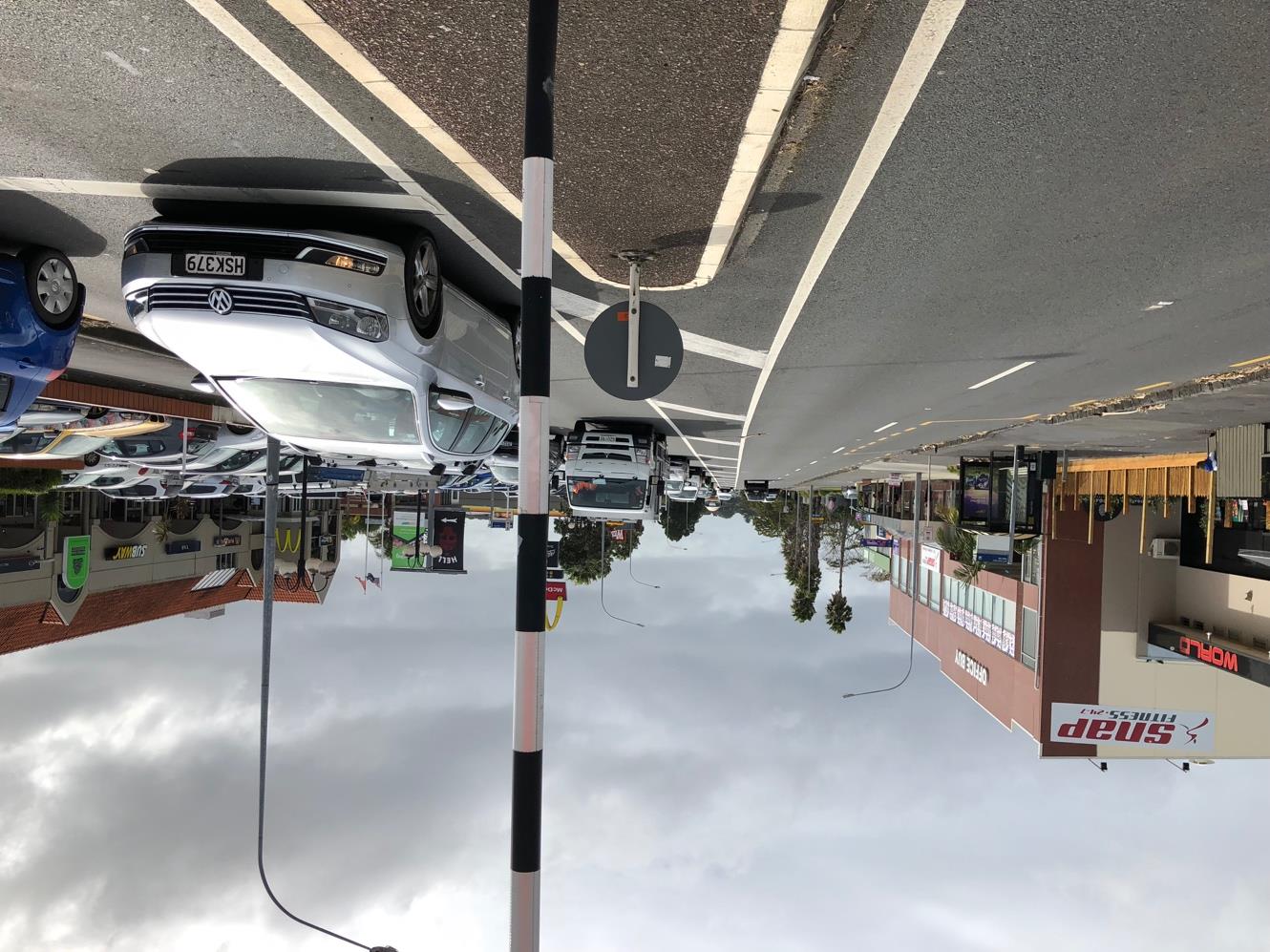 Robinson Transportation Consulting
Robinson Transportation Consulting
Figure 4 Queue backup on Mount Albert Road
Particularly on multi-lane arterial routes, drivers reasonably expect to continue through an
intersection in either lane. Specifically, on Mount Albert Road which is four lanes wide, the
design lane arrangement would result in a left lane “trap” for drivers who may expect to
optionally proceed straight through the roundabout to Mount Smart Road from this lane
(although Mount Smart only has one exit lane). This could cause unsafe late lane changes
to avoid the trap. Of note is that the proposed design extends the raised splitter island on
Campbell Road into the currently white-hatched circulatory roadway which more clearly
differentiates the Campbell Road exit from the Mount Smart Road exit for Mount Albert
Road and Manukau Road (southbound) entrants. While eliminating this acute-angled
adjacent exit confusion, it also foreshortens the room for late lane changes, thus
accentuating the need for clear and timely lane per-segregation cues on Mount Albert Road
and Manukau Road (southbound).
- 9 -
Revision A
20/06/2018
RoyalOakSafetyReview_v1
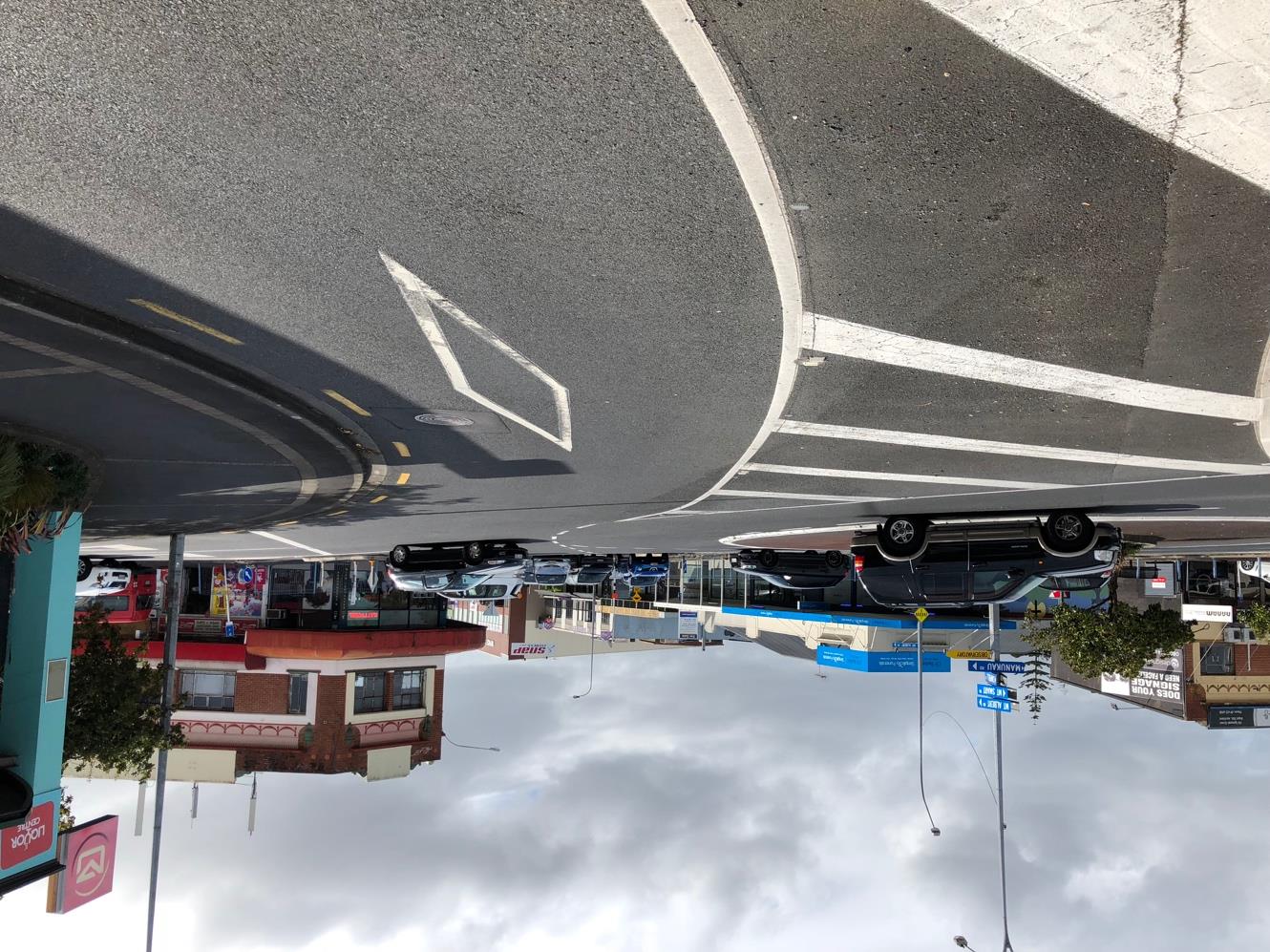 Robinson Transportation Consulting
Robinson Transportation Consulting
Figure 5 Trap lane from Mount Albert Road entry to Campbell Road exit
Recommendations
a) Re-locate the ADS signs as far upstream on each approach as required to allow for
safe lane changing prior to joining the back of queues during peak periods;
b) Provide repeated turn lane markings upstream of peak period queues on each
approach to encourage pre-segregation;
c) Extend solid lane lines on Mount Albert Road approach upstream of the pedestrian
crosswalk to discourage late lane changes.
2.4 Deflection and path overlap through the roundabout
(O.U=Moderate)
The entries into the roundabout appear to be perpendicular to the central island and have
relatively low deflection. Thus, it is possible for drivers to enter the roundabout at
inappropriately high speeds and they may then be forced to slow quickly into the circulatory
lane. This could increase the likelihood of loss of control. Specifically, the inside entry lanes
closest to each splitter island are not oriented tangentially to the central island truck apron.
At unconstrained sites, best practice is to offset the approach entry paths to the left of the
central island (including any apron) to manage entry speeds into the circulatory roadway
with the minimum vehicle speed being achieved at the roundabout limit line. This can
generally be achieved geometrically by resetting of the splitter island leading edge and the
- 10 -
Revision A
20/06/2018
RoyalOakSafetyReview_v1
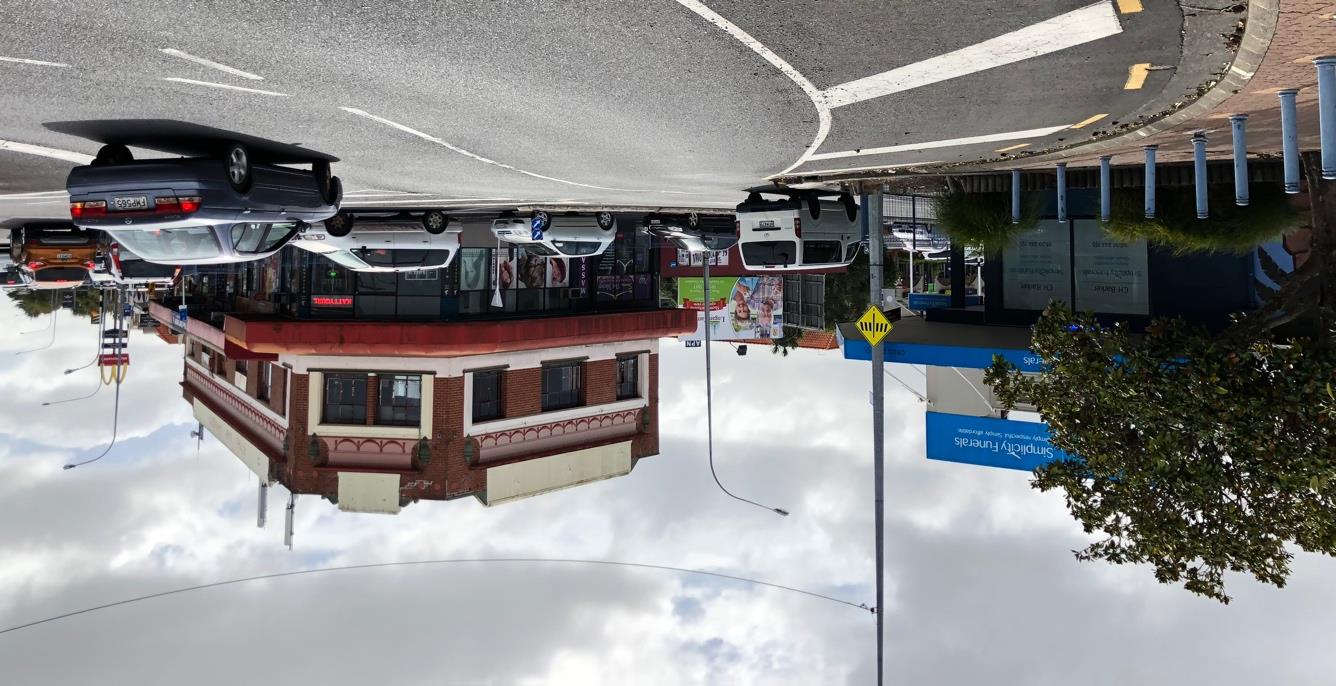 Robinson Transportation Consulting
Robinson Transportation Consulting
kerb radius, re-shaping the entry curve radius to offset to the left of the central island. In
conjunction with this kerb geometry, the entry lane markings should be targeted toward
their matching circulatory lane in front of the next downstream splitter island.
On Campbell Road and Mount Smart Road each with adjacent “through” entry lanes both
destined to exit at Mount Albert Road, this lane geometry can encourage drivers in adjacent
shoulder lanes to take the shortest path through the circulatory roadway, with their path
overlap into the inside lane cutting off the inside lane vehicles during circulation. It is
perhaps noteworthy that a full Dutch “turbo-roundabout” design with kerb separated lanes
would eliminate the possibility of path overlap on the circulatory roadway and also help to
manage speeds.
Fast tangential exit speeds increase the likelihood of loss of control type crashes and the
potential for higher speed crashes involving pedestrians crossing the road near the exits.
This could be a safety issue at the Campbell Road exit as well as at the Manukau Road south
exit leg Therefore, the detailed design should include the consideration of the speed path
profiles through the roundabout to demonstrate safe speeds, through both the circulatory
path and on the higher speed through lane entries and exits.
On the other hand, on multi-lane exits, perpendicular exits can cause exit path overlap,
particularly for heavy vehicles. For example, the double lane exit to Mount Albert Road
has a severe left turn on exit arrangement which adjacent trucks or buses are unable to
negotiate without crossing the exit lane markings (see swept paths in Appendix B). This
will lead to side-swipe conflicts and crashes.
Figure 6 Constrained exit to Mount Albert Road
The roundabout central island also includes an apron. Any vertical kerb “nib” between the
inner circulatory lane and the apron next to roundabout islands can be hazardous for
motorcyclists, particularly if the entry path offsets, referred to above, have not been
provided. The crash record includes that 4 of the 17 injury or fatal crashes involved
motorcyclists/mopeds (Appendix C).
- 11 -
Revision A
20/06/2018
RoyalOakSafetyReview_v1
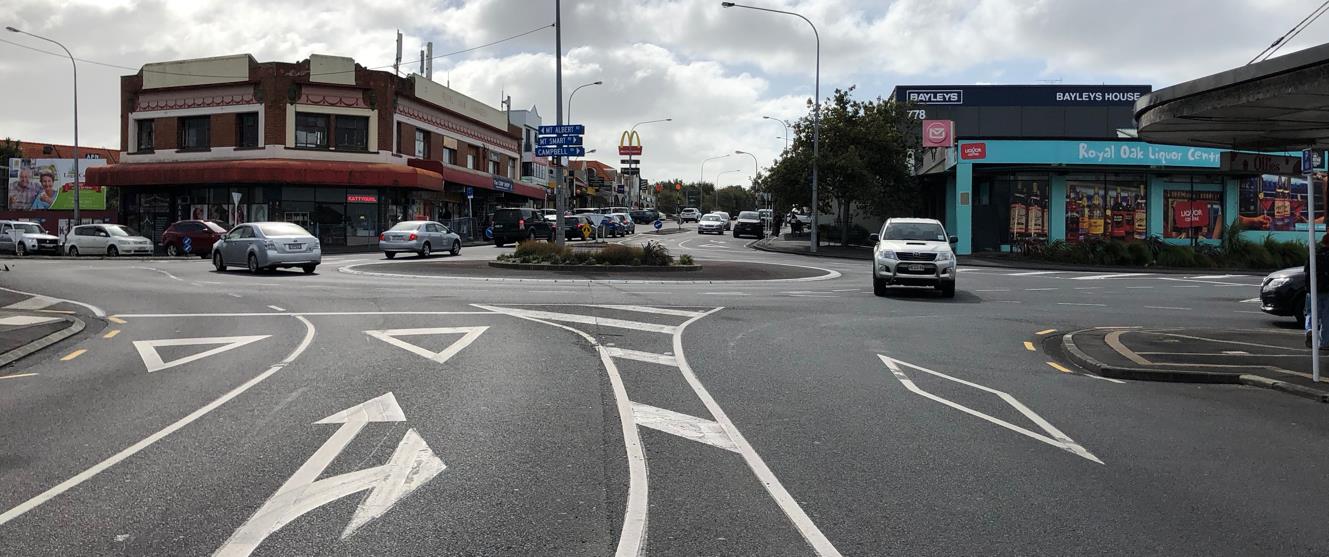 Robinson Transportation Consulting
Robinson Transportation Consulting
Recommendations
a) At detailed design stage, assess the speed path profiles through the roundabout and
provide for safe speeds: through both the entry and circulatory path, with the inner
entry lanes being sufficiently offset from and as tangential to the central island as
possible; to reduce path overlap for through traffic entering at Campbell Road and
Mount Smart Road, and to reduce speeds on the tangential exit lanes at Campbell
Road and Manukau Road south exit.
b) Design the mountable central island apron kerb to be sufficiently offset from the
fastest travel paths and flush with the pavement surface to minimise the tripping
hazard for motorcyclists;
c) Correct the geometry to avoid an exit lane path overlap conflict point for heavy
vehicles at Mount Albert Road exit;
2.5 Central island conspicuity (O.U=Moderate)
The central island currently consists of a small diameter, relatively wide mountable apron,
with a lamppost in the centre and street name signs indicting each exit leg. However, it is
evident from the lack of wheel tracks that the apron is not used much and indeed the whole
island is very inconspicuous and unreadable with no target value, being almost flush with
the circulatory roadway.
Figure 7 Inconspicuous central island
The proposed design will increase the central island and reshape it with two “cams” to
develop right turn spiral lanes from. The exact shape has been determined from the non-
traversable “remnant” as indicated by the inside track requirements of the design vehicle
swept paths (Appendix B).
Reconfiguration of the central island provides an opportunity to increase its target value by
incorporating heightened visual elements (e.g. vegetation, mounding, artwork) that would
provide a terminal vista so that drivers notice the presence of the central island rather than
having their gaze distracted across to the far side of the intersection.
- 12 -
Revision A
20/06/2018
RoyalOakSafetyReview_v1
Robinson Transportation Consulting
Recommendations
a) Incorporate heightened visual elements into the enlarged central island to provide
a terminal vista from each roundabout approach to improve legibility and
recognition that this is a roundabout intersection as well as clearly demarcating the
location of the island that must be circulated.
b) Provide the minimum truck apron or vertical elements that are necessary to provide
adequate forward stopping sight distance on the circulatory roadway.
2.6 Circulatory roadway markings (C.VU=Moderate)
The design has circulatory lane markings spiralling out from the cams on the central island
to the Mount Albert Road exit and the Campbell Road exit. As critical as ensuring the
correct exit paths are taken is ensuring that the correct entry paths from the giveway lines
to the correct circulatory lanes are made. Therefore the design could be improved by
providing these guide markings for the inside lanes leading from all entries expect Manukau
Road northbound where it is not needed.
As a further visual cue, the inner circulatory lane could benefit from having the turn arrows
repeated opposite splitter islands where there are two circulatory lanes at Manukau Road
north and south. The exclusive left exit lanes to Mount Albert Road and Campbell Road
would also benefit from repeater directional markings on the outer circulatory lanes
between the entry and exits. A graphical summary of these lane marking recommendations
is provided as Appendix E.
The proposed design shows solid lane markings in the southwest and northeast quadrants
of the circulatory roadway, similar to the raised kerbs in a Dutch “turbo” roundabout design.
These lane markings are intended to be mandatory and enforce lane-discipline. As such
they should be bold, and possibly treated with a different colour or possibly using audio-
tactile pavement markers.
Recommendations
a) Consider providing guidelines for the median entry lanes from the giveway line into
the correct inside circulatory lane for critical movements.
b)
Consider providing turning lane arrow markings in front of the splitter islands in
the multi-lane circulatory roadway.
c) The solid spiral lane markings in the southwest and northeast quadrants of the
circulatory roadway could be made more conspicuous through a combination of
wider and different colour and/or by including audio tactile pavement markings.
- 13 -
Revision A
20/06/2018
RoyalOakSafetyReview_v1
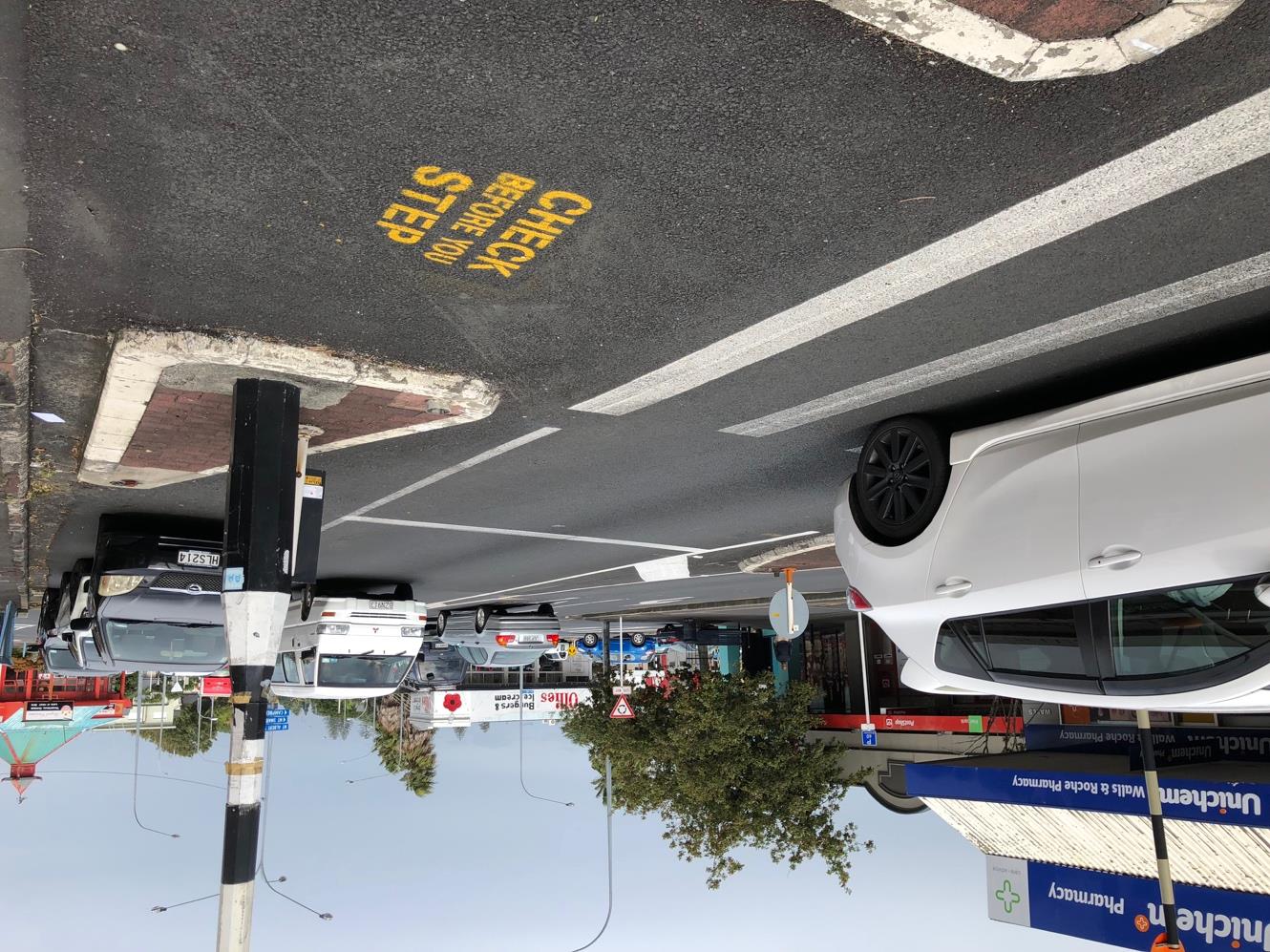 Robinson Transportation Consulting
Robinson Transportation Consulting
2.7 Pedestrian crossing points at roundabout splitter islands
(C.L=Significant)
Pedestrians have been involved in 5 of 17 injury or fatal crashes (Appendix C).
Furthermore, the traffic surveys (Appendix D) indicate that there is significant pedestrian
activity throughout the day and early evening. Two of the legs (Campbell Road and Royal
Albert Road) currently have active road studs at the crossings. At four of the five legs there
are currently ramped kerbs off the sidewalk at pedestrian crossing points and flush
pedestrian refuges through the splitter islands.
The proposed design plans to replace these with 100mm raised pedestrian crosswalks,
similar to the ones on Mount Albert Road, but painted red with white zebra stripes. As well
as providing vertical deflection for vehicles crossing them, they will be flush with the
sidewalks making it easier for all non-vehicle users to cross comfortably. It is not clear
whether ative road studs are being considered at the other crosswalks, but these should be
considered for consistency and safety enhancement.
On Manukau Road north and south legs there are some parking spaces either within the
functional area of the intersection between the crosswalks and the giveway lines, or
upstream that are limiting pedestrian sight distance and resulting in conflicts (side-friction)
with through traffic when parking or leaving. It is suggested that any parking spaces that
are within the functional area of the intersection or limiting sight distances to the crosswalks
be removed (Appendix E).
Figure 8 Car parking obfuscation
- 14 -
Revision A
20/06/2018
RoyalOakSafetyReview_v1
Robinson Transportation Consulting
Finally, during the site visit, it was noticed that the busy crosswalk at the Manukau Road
north leg was frequently causing car queues in the single exit lane to back up into the
roundabout, thus blocking other movements. This operational matter is resulting in a safety
concern by causing vehicle-vehicle conflicts in the roundabout. It is left to the designers to
investigate possible solutions which may include some combination of a signalised
crossing; dual exit lanes (shown in Appendix E); or re-location of the crossing point.
A Sidra 95th percentile queueing analysis of this crossing during the PM peak estimates a
107m queue northbound, which would block the upstream roundabout and a 1304m queue
southbound. If there were dual northbound exit lanes from the roundabout, tapering back
to a single lane 60m after the crossing, then the northbound queue would reduce to 41m
(and the southbound queue would remain 1304m, as before).
Recommendations
a) Remove all parking spaces within the functional intersection areas between the
crosswalks and giveway lines on Manukau Road exits and Manukau Road
northbound entry.
b) Provide adequate dynamic sight distance of pedestrians by removing any parking
space within 1 car length from the crosswalk on each approach on Manukau Road
north and south.
c) Retrofit the existing Mount Albert Road crosswalks to have a consistent design and
marking treatments to the new raised crossings on the other legs.
d) Consider providing active road studs at all crosswalks for safety and consistency.
e) Design a solution for the queue spillback from the Manukau Road northbound exit
due to the high pedestrian crossing activity during peak periods.
2.8 Bicycle path continuity and wayfinding (O.VL=Significant)
The crash evidence indicates that 5 of 17 crashes involved bicyclists, also noting that a
further 4 involved motorcycles or mopeds (Appendix C). Multilane roundabouts are
difficult for less confident cyclists to negotiate in the general traffic lanes, particularly if
they have more than 4 legs as occurs at Royal Oaks. Therefore, recommended practice is
to provide an alternative off-road path for less confident cyclists as multi-lane roundabouts.
In this case, the variable circulatory roadway also makes it difficult for cyclists to pre-
segregate into the correct lanes to negotiate the intersection by requiring them to claim an
inside lane rather than a shoulder lane to certain destinations.
The sidewalks on some corners of the intersection are quite narrow so off-road bicyclists
should be instructed by supplementary signs at the shared path “begins” points to dismount
or otherwise give way to pedestrians. This should also apply at the crossings.
For the more confident on-road riders, there should be signs after the ADS signs and
upstream of the crossings instructing them to “claim the lane” to negotiate the roundabout
- 15 -
Revision A
20/06/2018
RoyalOakSafetyReview_v1
Robinson Transportation Consulting
as a vehicle would, to their destination. In some cases, for right turns a lane change from
the shoulder to the inside entry lane may also be necessary.
A possible solution to provide protected entry into either of the roundabout entry lanes when
a bicycle approaches (e.g. in a short shoulder bicycle lane) could be to briefly stop other
vehicles at crosswalk signals when a bicycle actuates a sensor. These crosswalk signals
could also be actuated by pedestrians rather than the current “on-demand” pedestrian
priority crossing, thus bunching pedestrians to cross in groups during their own green phase.
Metering the roundabout legs may also provide more positive control to optimise
roundabout performance during peak periods.
Recommendations
a) Provide an alternative off-road shared path and wayfinding provisions for less
confident cyclists to cross the roundabout;
b) Provide optional bicycle ramps to and from shared crossings through the
roundabout intersection to provide a safe off-road crossing.
c) Provide supplementary signs at the beginning of the shared paths and crossing
points requiring off-road bicyclists to dismount or give way to pedestrians.
d) Provide signage upstream of the crossings of the need for on-road bicyclists to
claim the general traffic lane appropriate to their destination and proceed through
the roundabout as a vehicle.
e) Consider a signal metering solution at each crosswalk approach that provides
bicycle priority into the roundabout entry lanes and possibly protected signalised
crossings for pedestrians.
- 16 -
Revision A
20/06/2018
RoyalOakSafetyReview_v1
 Robinson Transportation Consulting
Robinson Transportation Consulting
3 Review Statement
I certify that I have used the available plans, and have examined the specified roads and
their environment, to identify features of the project that I have been asked to look at that
could be changed, removed or modified in order to improve safety. The problems identified
have been noted in this report.
Signed:.........................................................................
Date: 18/05/2018
s7(2)(a) Privacy
, Pr.Eng. (RSA), M.Eng., B.Sc.Eng. (Civil)
Robinson Transportation Consulting, Tauranga
- 17 -
Revision A
20/06/2018
RoyalOakSafetyReview_v1
 Robinson Transportation Consulting
Robinson Transportation Consulting
Appendix A: Roundabout Improvements Concept Design
Revision A
- 1 -
20/06/2018
RoyalOakSafetyReview_v1
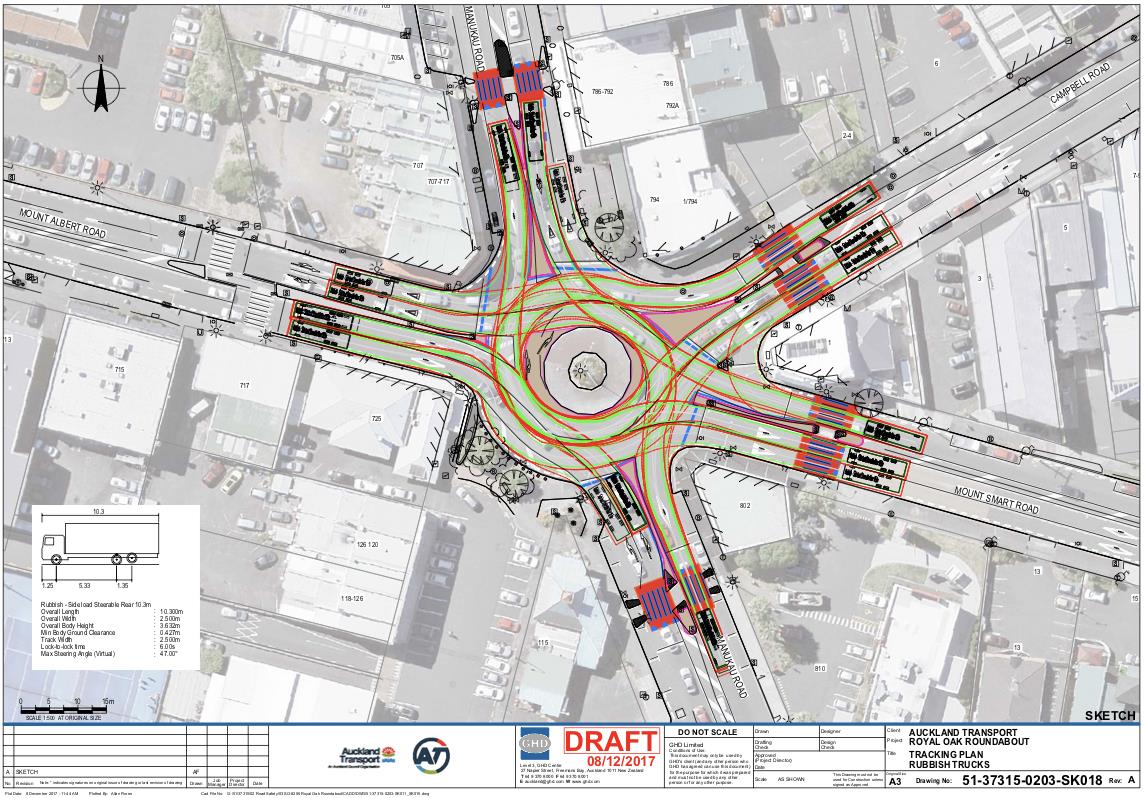 Robinson Transportation Consulting
Robinson Transportation Consulting
Appendix B: Tracking Curves (Rubbish Trucks)
Revision A
- 2 -
20/06/2018
RoyalOakSafetyReview_v1
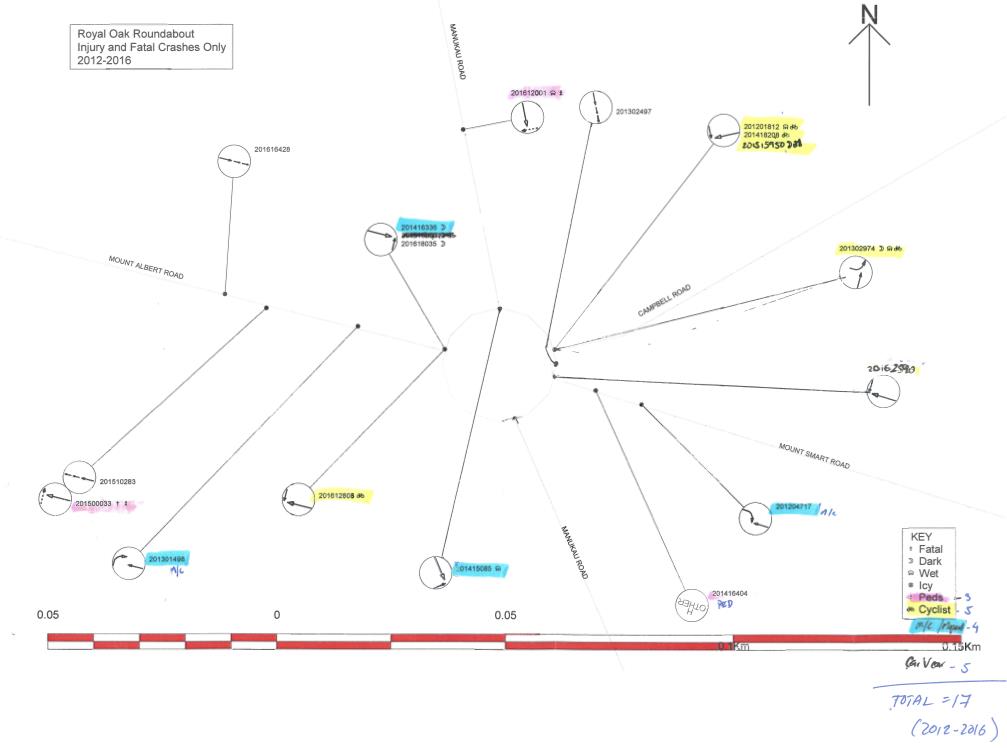 Robinson Transportation Consulting
Robinson Transportation Consulting
Appendix C: Crash Record (2012-2016)
Revision A
- 3 -
20/06/2018
RoyalOakSafetyReview_v1

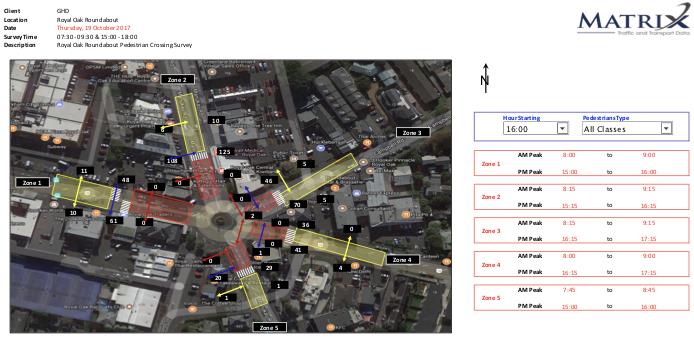 Robinson Transportation Consulting
Robinson Transportation Consulting
Appendix D: Traffic Surveys
Figure 9 Pedestrians 8-9am
Figure 10 Pedestrians 4-5pm
Revision A
- 4 -
20/06/2018
RoyalOakSafetyReview_v1
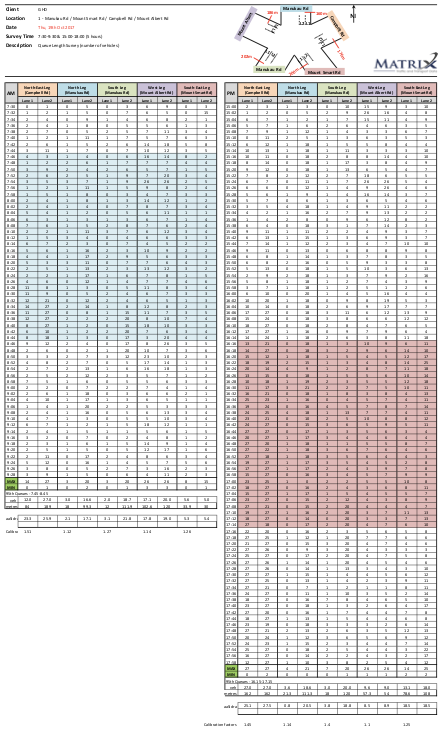 Robinson Transportation Consulting
Robinson Transportation Consulting
Figure 11 Queues
Revision A
- 5 -
20/06/2018
RoyalOakSafetyReview_v1
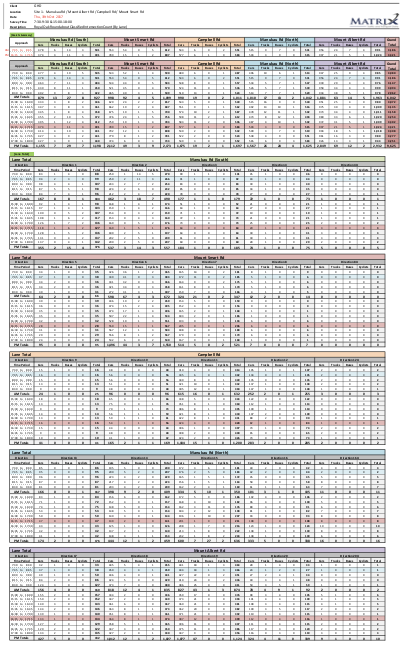 Robinson Transportation Consulting
Robinson Transportation Consulting
Figure 12 Traffic Turning Counts
Revision A
- 6 -
20/06/2018
RoyalOakSafetyReview_v1
 Robinson Transportation Consulting
Robinson Transportation Consulting
Appendix E: Review Markup* of Roundabout Improvements Concept Design
* Please consult relevant text for context (for discussion purposes only, not for final design)
Revision A
- 7 -
20/06/2018
RoyalOakSafetyReview_v1





















